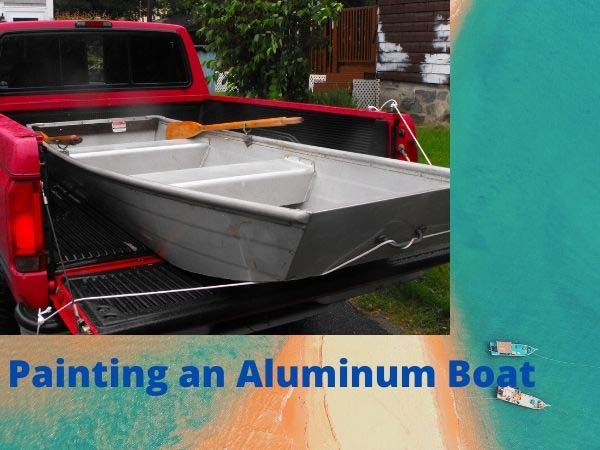Do you want your boat always to look stunning as though as it’s new? If that’s the case, then you need not overlook the significance of applying fresh paint. Here’s an exhaustive guide on everything you need to know about how to paint a boat. And while applying paint might seem like a tedious task, it’s relatively easy.

All you need are some simple guidelines on the steps to follow while painting your boat, and in no time, it will be looking as good as new. If you’re prepared to undertake this process but don’t know where to start, you’ve come to the right place. With this, you’ll be in a great position to restore your boat to an excellent condition in no time.
10 Steps To Follow When Painting Your Boat
Painting your boat is a step-by-step process. You must follow all these steps correctly to ensure your boat’s look doesn’t get ruined altogether.
Here are the 10 steps to follow for painting a boat:
- Gather the tools and materials
- Prep your boat
- Clean your boat
- Remove all the hardware
- Remove the wax coating
- Mark the area you intend to paint
- Scrape off the peeling paint
- Sand your boat
- Paint the boat
- Remove the painter’s tape
Gather The Tools And Materials
Before you can start painting your boat, make sure you have some useful tools and materials, including;
- Putty knife
- Mask
- Paintbrush
- Primer
- Tape
- Protective glasses
- Paint roller
- Epoxy filler
- Dewaxing solvent
- Rag or tack cloth
- 80 to 120 grit sandpaper
- Finishing sander or random orbital sander
- Boat bottom paint
- Topside boat paint
Once all these items are assembled, you can now embark on your boat painting journey, and here’s an overview of the steps to follow.
Prep Your Boat
This is undoubtedly the most vital part of the cleaning of your boat. Because of this, you need to take your time, and here are some of the activities that will be involved when doing all this.
Clean Your Boat
The first thing to do is thoroughly cleaning your boat. It’s best to do this immediately once you’ve taken your boat out of water because, at this point, it’s a lot easier to clean. And when doing the cleaning, make sure to use a high-pressure hose or wash together with rags and a scraper.
Once you’re almost done cleaning your boat, make sure to rinse it thoroughly and ensure no soap is left on your boat. And after a thorough cleaning job, you can be sure that sand, dirt, or hard growth won’t interfere with you achieving a clean paint job. How to clean a boat hull is a cleaning related article that could be helpful for you.
Remove All the Hardware
You must take out as much as possible to achieve a clean and smooth paint job. And although this might be time-consuming, it’s the only way to guarantee that your paint job efforts don’t go to waste. This step entails removing all the aluminum siding on your boat, but if there are hardware pieces that completely don’t come off, place a painter’s tape over them.
It’s essential to make sure that all the hardware has been removed because the paint will be on the boat’s hardware piece. As a result, this paint is more likely to allow debris and water to penetrate, which makes it start cracking over time.
Due to this peeling off paint and flaking, another paint job will be necessary, which is expensive and time-consuming. Therefore, you should avoid such possible issues in the future by thoroughly removing all the hardware from your boat’s surface.
Remove the Wax Coating
Paint or primer doesn’t stick to the wax. And because almost every boat comes applied with a wax finish, it’s essential to make sure it’s removed before applying the paint to avoid possible issues. If unsure whether your boat has a wax finishing, run your finger along the boat’s surface for a definitive answer.
When removing the wax coating, you need to use boat solvents. And as you do this, make sure to apply some pressure when using the coarse sponges to ensure all the boat’s wax has been removed. This might take your time, but you should only proceed once you feel no boat wax is left on the boat.
Mark the Area You Intend to Paint
It’s critical to identify the area that needs painting. This means inspecting dings, dents, and any other area where the paint is peeling or flaking. Once you’ve identified these spots, go ahead and mark each of them using a tiny piece of tape to make it easier for you to pick out the areas which you should address.
Scrape off the Peeling Paint
Once water and air find their way between the boat’s surface and paint, it causes the paint to start peeling. And this will continue happening even after you’ve applied a fresh coat of paint or primer. If you don’t want to waste your time and efforts, start by scraping off the boat’s paint. By removing all the peeling paint, you’ll be able to make sure it’s spread uniformly and well-adhered.
When the paint you’re applying differs from that of your boat, you need to scrub and sand off the entire pre-existing paint. You should do this using a sharp-putty knife and, while doing this, confirm the knife’s edge is parallel to your boat’s surface. By doing this, you avoid cutting the boat’s surface and making new dents, which is more work.
Sand Your Boat
Get 80-grit sandpaper and start sanding the whole boat surface. Doing this is essential since it improves the paint’s grip on the surface and facilitates the uniform coat of paint. When sanding your boat, there are crucial things you need to observe, including;
- Never use a belt sander on the boat.
- Completely stripping off the old damaged or flaky paint entirely.
- Wearing eye protection and a respirator while sanding due to safeguard yourself from the toxic paint chops.
Paint Your Boat
The next to do after prepping and priming your boat is the paint job. Here’s an outline of the steps you should follow when painting your boat.
- Use a rag to wipe your boat: You need to wipe away any loose dirt or dust that’s accumulated on the boat’s surface using a tack cloth after the primer dries.
- Tape your boat’s edges: After wiping down the whole area, go ahead and tape along the boat’s edge of the topside and the waterline. And as you do this, always make sure to be using a long-mask tape. It’s advisable also to consider antifouling or to cover the region underneath your boat.
- Go through the manufacturer’s paint guidelines: There are different kinds of topside boat paints. Therefore, it’s essential to review the manufacturer’s paint instructions before you can start to paint. Doing this is crucial since certain paints have specific mixing instructions while others need thinner. Thus, it’s evident that you need to always adhere to the manufacture’s guidelines before you can begin applying the fresh coat of paint.
- Apply the first paint coat: Feel free to start applying the fresh paint after mixing the paints as advised by the manufacturer’s manual. You can choose to either apply the paint by brushing or rolling the topside coat, but first read the manufacturer’s manual to see if they recommend it.
When brushing or rolling vertically to the waterline, first ensure to start with a small area and take shorter strokes. And while rolling or brushing the paint, make sure to do this parallel to the finish’s waterline. Once you’re done, give the paint time to dry and then go ahead to other needed coats as advised in the manufacturer manual.
Remove the Tape
You should start taking out the tapes before drying the last coat of paint. Doing this is essential because leaving the final coat of paint to dry increases the chances of the paint to peel together with tape. Due to this, you’ll need to start the prepping and painting of your boat again.
Do You Have To Sand A Boat Before Painting?
Yes, sanding your boat before you start painting is a must. Doing this necessary to remove all the old coat of paint that might have flakes or loose material after water or air found its way underneath.
If you don’t sand this surface before applying the fresh coat of paint, this loose material will remain on the boat’s surface. And over time, this will result in it starting to peel off slightly, meaning your hard-earned money and efforts painting the boat all go to waste.
Therefore, you must never skip this step if you’re committed to ensuring your boat gets to retain its impeccable look once you’re done painting it.
How Do You Paint A Boat Hull
One part of your boat that needs to be extreme care of when painting the boat hull. If you don’t observe this, the paint will start to peel off quickly, wasting your money and efforts. The steps to follow when painting the boat hull are;
- Use a sponge to apply an industrial solvent to the surface of the boat hull
- Clean the boat hull using power sand to get rid of old paint remains
- Fix any existing flaws in the hull before using a roller to apply the primer
- Use a painting brush and roller to apply the marine paint layer
- Give the paint a few hours to dry
How Do You Paint The Boat Bottom
The area underneath your boat gest exposed to water and different organisms and growth. Because of this, it’s necessary to use different paint to that used when painting the boat’s top parts.
The paint to use when applying the areas under your boat have biocide, which is a type of copper that fades away over time. This boat bottom paint is essential in preventing barnacles as well as marine growth.

Here’s an outline of the steps to follow when painting your boat bottom:
- Select the desired bottom paint: Due to the broad range of paints to apply underneath your boat, it can be confusing to pick the ideal choice. The main factor to consider when picking the most suitable one is identifying the region or climate you’ll use your boat.
- Prepare and sand your boat: Like painting your boat’s topside, preparation, before you start painting the bottom side is essential. This entails removing all the peeled or loose old paint if your boat was already painted. If the bottom area wasn’t painted, there’s an additional step to follow, and for Hydro coat, this means applying 92 Bio-Blue Hull Surface Prep. However, this process differs from the painting product, so you need to go through the manufacturer’s instructions.
You should also sand your boat before applying the fresh coat of paint regardless of whether it had paint or not.
- Apply the paint: Once you’ve adequately mixed the paint; go right ahead and apply it on your boat. And as you do this, make sure to continually stir it because some of the ingredients, such as cuprous oxide, usually settle on the container’s base.
How to Paint the Boat Deck?
You’re required to mask off the boat’s bottom part with an extreme care deck before painting it. When doing this, you should ideally use a 3M masking tape, which is the preferred option by many boat owners.
After you’re done, go ahead and using a solvent to get rid of all traces of dust and dirt on your boat. You should then thoroughly mix the paint using a high-nap roller. Once you’re through, please take off the paint and give it one to two days to dry.
What Kind of Paint Do You Use on a Fiberglass Boat?
There are three different types of paint you can choose to apply to your fiberglass boat. This includes;
- Two-part polyurethane paints: If you want the best quality paint for your fiberglass boat, look no further. The two-part polyurethane paint looks the best and lasts for the longest period ensuring your boat retains its appeal. Nonetheless, their application is labor-intensive because they need specific humidity levels and exact temperatures to mix the primer. Also, they’re costly.
- Single-part enamel paints: If you’re on a budget and searching for the best value, look no further since this paint offers you just that as it’s affordable. It’s also easy to apply. With that said, it has some downsides, including the constant need to be maintained and waxed due to its fragility when exposed to UV rays, which destroy its gloss over time.
- Single-part polyurethane paints: These paints guarantee to last for long and are cheaper than the two-part polyurethane paints; this is the perfect pick. Due to their long-lasting gloss and affordability, they have become a popular choice for fiberglass boat owners.
How to Paint a Fiberglass Boat
There’s isn’t a lot that differs in how you paint a wooden and fiberglass boat apart from several details during prepping and application and the kind of paint used.
And for the best outcome, spray paint must be used instead of a roller or brush and for this task to be done by a professional. With that said, you can still paint your fiberglass boat, but you need to maintain extreme caution throughout this entire process.
The steps to follow when painting your fiberglass boat are;
- Inspect the boat’s hull to see whether there are any holes or cracks and use putty to do these repairs. And while doing this, you also need to sand your boat to remove any rubber or silicone caulking and old stripes of vinyl graphics.
- Apply a layer of epoxy to strengthen and safeguard the boat’s fiberglass surface.
- Apply a primer layer and give it time to dry before sanding the surface.
- Start applying ablative anti-fouling paint on your fiberglass boat.
How to Paint an Aluminum Boat
The popularity of aluminum boats has slowly been on the rise because they’re fun exploring water and inexpensive. But to best enjoy using this boat, you need to properly look after it to ensure it remains in excellent conditions, and this includes repainting it with a good aluminum boat paint after some time.

The steps to follow when repainting it include;
- Apply the paint stripper to help ease the hassle of removing the old paint on your aluminum boat.
- Sand your boat to remove all the imperfections that might be on the surface. You can start by using 220-grit sandpaper and advance to achieve your wished polish level.
- Thoroughly wash your boat using mild soap and water to remove all the dirt and dust. Once you’re done, make sure to rinse your boat correctly.
- Proceed to apply the primer coat.
- Once the primer dries, go ahead and paint at least two layers of aluminum coat.
- Proceed to apply a clear protective coat once you’re done with the painting. This prevents scratches and ensures the paint remains undamaged.
Let’s Watch A Video On How to Paint An Aluminum Boat
Applying Non-skid Paint for Boat
The application of non-skid paint is essential to give it additional protection and ensure the boat doesn’t slip easily. But before doing this, you need to start by picking the right paint to apply to your boat. Here’s an outline of the different ways to apply non-skid paint on your boat;
- Broadcast the powder using your hands all over the boat’s surface.
- Stir the powder in the paint and then proceed to apply it. This technique is somewhat complicated because you’ll need to make sure the powder doesn’t bunch up when pressure is placed under the brush or roller, resulting in an irregular effect.
- Drill several 3mm holes onto a plastic container on the lid and start using the container as a big pepper shaker. Do this until the entire surface gets covered with a powder layer.
What to See When Selecting a Boat Paint?
It can be quite confusing to decide which boat paint to pick with many options on the market. But to know which boat paint best suits you, there are a few useful tips to consider, including;
- Identify the area on your boat that needs to be finished.
- Determine the types of look you want your boat to have once you’re through painting it.
- The manufacturer of the paint, primer, and every other compound needed. You should ideally use products from one manufacturer.
How Long Does Boat Paint Last?
How long does your boat paint last? The fresh coat of paint you’ve applied will inevitably start wearing off due to exposure to the harsh environmental elements.
You’ll start to notice the paint of your boat scrapping or peeling after four to five years. It really depends on your boat type, paint quality, use of the boat, type of water, boat storage, etc. And there are a couple of signs you need to be on the lookout for, including;
- Peeling of paint on specific areas of your boat.
- Craters resembling the look of a moonscape on the boat’s surface.
- Blisters on the surface of your boat are caused by water getting trapped underneath the paint bubble.
How Much Does It Cost to Paint or Repaint a Boat?
The cost you incur painting your boat depends on a couple of factors, including;
- The boat’s size
- Difficulty painting the boat
- The kind of materials needed
- The degree of repairs necessary
If you decide to do the painting job by yourself, be ready to spend about $1,500. However, the average cost you’ll spend if you choose to hire a professional will range between $2,500 to $3,500 or more. And while you might be tempted to paint your boat on your own, it’s crucial to factor in various factors such as the energy, how challenging this is, and how much money you’ll spend.
How Long Does It Take to Paint a Boat?
The duration you take to finish painting your boat ranges between two to four days. How long this should take you also depends on your boat’s size and whether you encounter any interruptions when painting your boat, such as rain. But if everything goes smoothly, you shouldn’t take more than four days to be done painting your boat.
Conclusion
The process of how to paint a boat is one that many boat enthusiasts are always eager to know. If you also wanted insight on how to go about all this, reading this in-depth guide has been of great help. With these insights, you can now go ahead and paint your boat and ensure it remains in superb condition.



